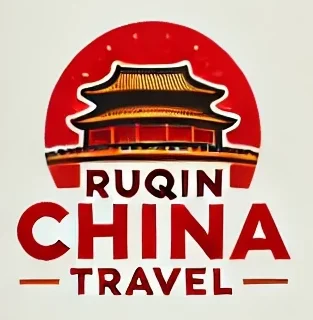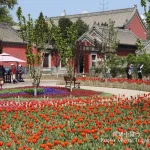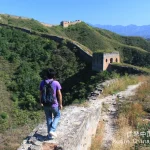Tucked away in the heart of Beijing, the Confucius Temple and Imperial College Museum (孔庙和国子监博物馆) is a true hidden gem for history lovers. This cultural site is one of China’s best-preserved treasures of ancient education and Confucian heritage.
This guide is specially written for international travelers. We’ll walk you through everything — from historical background and must-see spots, to practical tips and suggested routes. Whether you’re a culture buff or just looking to explore beyond the usual tourist trail, this UNESCO World Heritage tentative site offers a fascinating glimpse into the intellectual heart of ancient China.
📚History and Cultural Background
The Confucian Temple and Imperial College Museum sits on Guozijian Street in Beijing’s Dongcheng District — also known as Chengxian Street (成贤街), or “Street of the Worthy.” This peaceful lane holds centuries of Chinese educational history.

The complex was first built in the 14th century during the Yuan Dynasty. It perfectly reflects the traditional Chinese layout of “temple on the left, school on the right” — a design meant to show the balance between reverence and learning.
🏛️The Confucius Temple
The Confucius Temple was built in 1302, during the Yuan Dynasty. It covers about 22,000 square meters. With its bright yellow glazed roof tiles, the temple exudes royal elegance — its grandeur even rivals the Hall of Supreme Harmony in the Forbidden City.

For centuries, emperors came here to honor Confucius, the great philosopher and educator. But the temple isn’t just ceremonial. It also holds 198 stone tablets inscribed with the names, birthplaces, and ranks of over 51,000 scholars who passed the imperial exams under the Yuan, Ming, and Qing dynasties. These tablets are a rare and valuable record of China’s ancient civil service system, known as the keju.
🎓The Imperial College (Guozijian)
Just next door is the Imperial College, or Guozijian (国子监). It was founded even earlier, in 1287, and spans a spacious 28,000 square meters. This was the top school in imperial China — the national university of its time — and the only surviving complex of its kind today.

At its heart stands the Biyong Hall (辟雍), built in 1783 during the reign of Emperor Qianlong. This magnificent structure was designed exclusively for the emperor to deliver lectures — it’s the only palace in the world built for that purpose. With its graceful architecture and excellent acoustics, Biyong is truly one of a kind.
🏺From Historic Site to Museum
In 2008, after major renovations, the Confucian Temple and Imperial College reopened as acombined public museum. The restoration carefully preserved the original layout and architecture.
Today, this site is more than a museum — it’s a living classroom. It’s been named both a Beijing Integrity Education Base and a Patriotic Education Site, offering visitors a deep look into China’s scholarly traditions and Confucian values.
🕒 Opening Hours & Best Time to Visit
The Confucius Temple and Imperial College Museum is open year-round, except Mondays when it’s closed for maintenance. However, opening hours vary by season:
👉Explore Our Curated Beijing Tours
- Peak Season (May–October): 8:30 AM – 6:00 PM
(Last ticket entry at 5:00 PM) - Low Season (November–April): 8:30 AM – 5:00 PM
(Last ticket entry at 4:30 PM)
🌸 Best Time to Visit
Spring and autumn are the most pleasant times to explore. Visit in April–May or September–October to enjoy mild weather and fewer crowds.
If you’re in Beijing around September 28th, don’t miss it — that’s Confucius’ birthday. The museum often hosts a traditional ceremony honoring the great teacher. It’s a rare chance to witness ancient rituals brought back to life.
🎟️ Tickets & Booking Info
💰 Ticket Prices
- Adults: 30 RMB
- Full-time university students (with valid student ID): 15 RMB
🆓 Free Entry
You can visit for free if you fall into one of the following categories (with valid ID):
- Seniors aged 60 and above
- Minors under 18
- Visitors with disabilities
📲 How to Book
The easiest way to reserve tickets is through the museum’s official WeChat account — just search for 孔庙和国子监博物馆. You can book up to 3 days in advance.
If you prefer to buy on the day of your visit, that’s fine too. You can scan a QR code at the entrance or purchase tickets at the on-site counter.
🕐 Note: The museum is closed every Monday, except on national holidays.
💡 Insider Tip
Every Wednesday, the museum offers 200 free tickets — but you’ll need to reserve them in advance on WeChat. Also, teachers get free entry on Teacher’s Day (September 10th), a lovely nod to Confucius himself!
🚇 How to Get There
The Confucius Temple and Imperial College Museum is located at No. 15 Guozijian Street, in Beijing’s Dongcheng District. It’s easily accessible by subway, bus, or taxi.
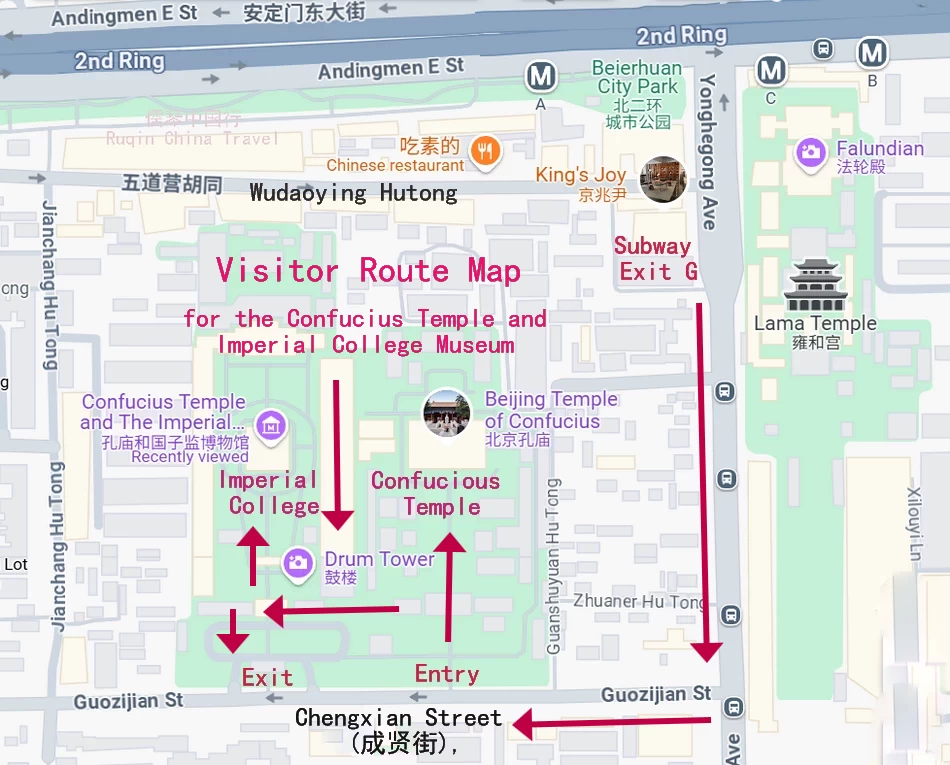
The official visitor route begins with the Confucius Temple, followed by the Imperial College (Guozijian). Please note that visitors are only allowed to enter through the Confucius Temple and exit through the Imperial College—there is no separate entrance to the Imperial College.
👉Explore Our Curated Beijing Tours
🚉 By Subway
Take Line 2 or Line 5 to Yonghegong Station (Lama Temple) 雍和宫.
Exit from Exit G, then walk south for about 180 meters.
Turn right into Guozijian Street 国子监街 (also called Chengxian Street) and walk another 230 meters — the museum will be right there.
🚌 By Bus
- Bus 104 or 108: Get off at Fangjia Hutong Station (方家胡同站), walk 100 meters north, then turn right into Guozijian Street.
- Bus 116 or 684: Get off at Yonghegong Station (雍和宫站), walk 50 meters south, then turn left into Guozijian Street.
🚕 By Taxi or Ride-Share
You can simply enter “Confucius Temple and Imperial College Museum” 孔庙和国子监博物馆 or “15 Guozijian Street” as your destination.
🌳 Bonus Tip
If you’re walking from Yonghegong Subway Station, take your time! Chengxian Street (成贤街) is one of Beijing’s best-preserved old streets. It stretches 680 meters and is shaded by old Chinese scholar trees. You’ll feel the charm of traditional Beijing with every step.
🏯 Must-See Highlights at the Confucius Temple
There’s a lot to take in at the Confucius Temple, but here are four highlights you definitely shouldn’t miss. These spots offer a deep glimpse into China’s imperial education system and its lasting reverence for Confucius.
📜 1. The Jinshi Stele Forest (进士题名碑林)
In the first courtyard, you’ll find 198 stone steles. They list the names, hometowns, and rankings of 51,624 Jinshi scholars — the top-tier graduates of the imperial exams from the Yuan, Ming, and Qing dynasties.
These steles are like a stone version of a graduation list. Among them, only three Yuan Dynasty steles survive — incredibly rare and valuable. Take a closer look! You might even spot a name you recognize from Chinese history.
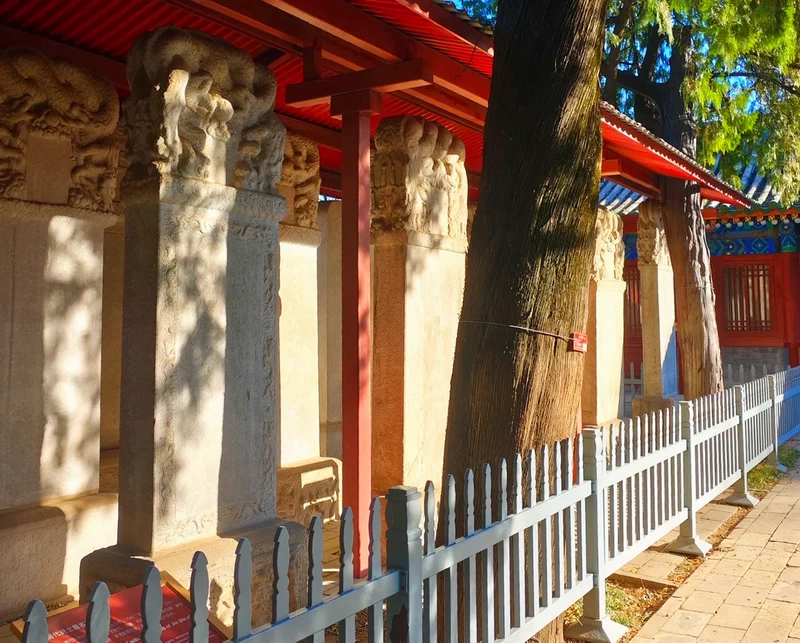
🥁 2. Dacheng Gate & the Stone Drums (大成门与石鼓)
Before entering the main hall, you’ll pass Dacheng Gate, guarded by a solemn white marble statue of Confucius. On either side of the gate stand 10 stone drums, modeled after ancient artifacts from the Zhou Dynasty. Each drum bears a poem carved in ancient script, celebrating royal hunting scenes.
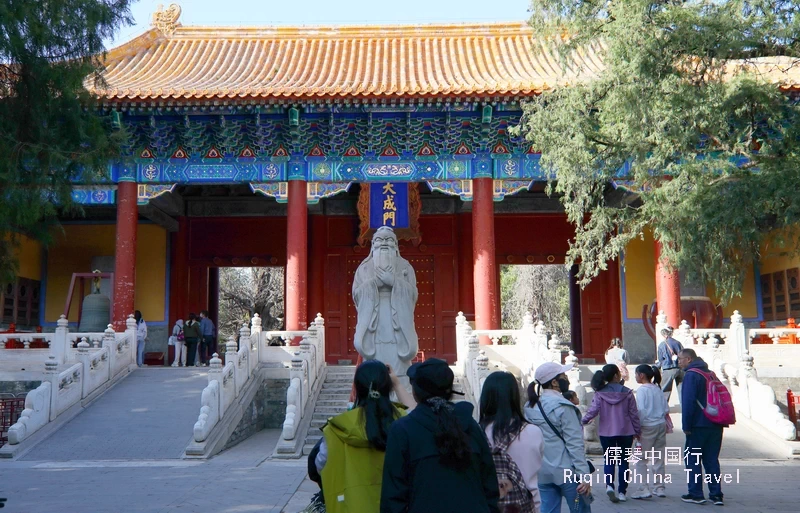
Don’t miss the central pathway leading into the gate. It features a beautifully carved relief of five dragons playing with a pearl — an image symbolizing imperial authority and divine wisdom.
🏛️ 3. Dacheng Hall (大成殿)
This is the heart of the temple and its grandest building. Its layout mirrors the Hall of Supreme Harmony in the Forbidden City, showing its high status in feudal architecture.
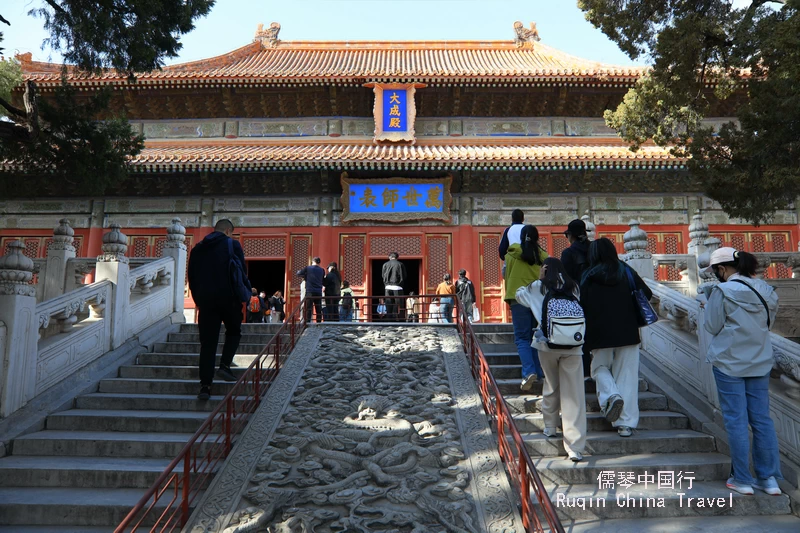
Inside, the floor is paved with gold-colored bricks. The ceiling is decorated with coiled dragons, and at the center stands a wooden tablet honoring Confucius as the “Most Sage and Venerable Teacher”. You’ll also see plaques for his key disciples — Four Associates and Twelve Philosophers.
Look up! Around the hall hang nine imperial plaques, each hand-written by a Qing emperor. These calligraphic works offer four-character praises to Confucius — a powerful tribute across generations.
📚 4. The Qianlong Stone Classics (乾隆石经)
Between the Confucius Temple and the Imperial College, you’ll walk through a narrow path lined with 189 stone steles. These steles are engraved with the complete texts of 13 Confucian classics, including the Book of Changes (Yijing), Analects, and Book of Songs (Shijing).
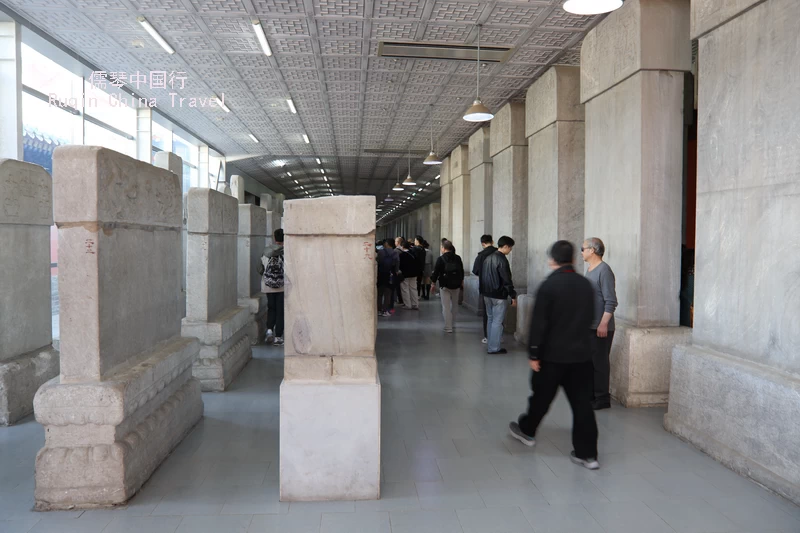
They were carved during the reign of Emperor Qianlong and are collectively known as the Qianlong Stone Classics. For anyone interested in Confucianism, this is a priceless resource — and a peaceful spot to reflect on ancient knowledge etched in stone.
🏫 Must-See Highlights at the Imperial College
The Imperial College (Guozijian) 国子监 was the highest educational institution in imperial China. Its buildings are rich in symbolism, and each corner tells a story. Here are the top highlights to look out for when you visit.
🏮 1. Glazed Archway (琉璃牌坊)
This is Beijing’s only decorative archway built specifically for education. It’s beautifully detailed and steeped in history. On the front, you’ll see the inscription “Huanqiao Jiaoze” 圜桥教泽 (meaning “Education Spreads Far Like a Round Bridge”). On the back, it reads “Xuehai Jieguan” 学海节观 (meaning “Discipline in the Sea of Learning”). Both were written by Emperor Qianlong himself.
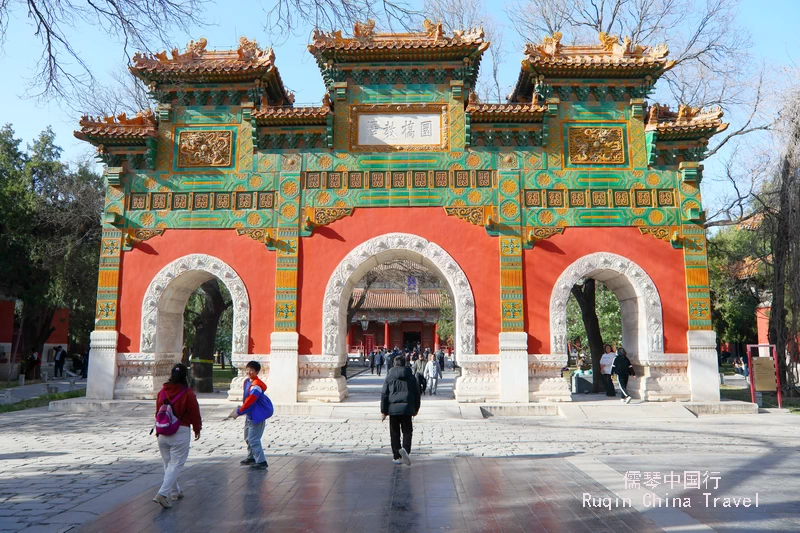
Notice the three passageways beneath the arch. Each had a purpose: civil officials entered from the left, military officials from the right, and the emperor alone used the center path — the majestic Dragon Gate.
Right next to the archway, you’ll spot a stone carving of a giant mythical turtle. Locals call it “Duzhan Aotou” 独占鳌头 — a symbol of academic excellence and a popular photo spot!
🏯 2. Biyong Hall (辟雍大殿)
This is the centerpiece of the Imperial College and its most impressive building. In fact, it’s the only palace in the world built specifically for an emperor to give lectures.

Biyong has a square layout with layered eaves and a roof of yellow glazed tiles, marking its royal status. A moat surrounds it, symbolizing the traditional idea of “Biyong Pan Shui” 辟雍泮水— learning in a place set apart, calm and pure.
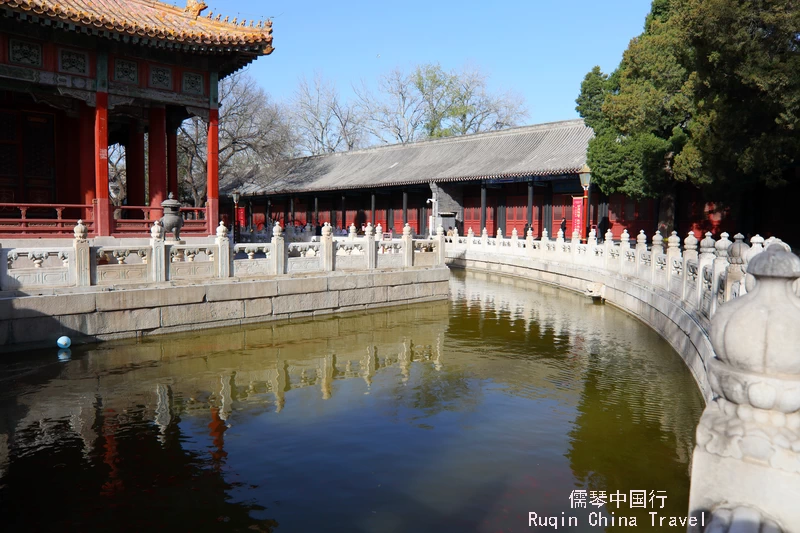
The acoustics here are excellent. Imagine the scene centuries ago: the emperor delivering a lecture from the hall, while 3,000 students knelt in silence in the courtyard. It was a powerful image of respect and learning.
📖 3. Yiluntang & Civil Exam Exhibit (彝伦堂与科举展览)
To the north of Biyong stands Yiluntang, once the college library. Today, it houses a permanent exhibition on the imperial examination system.

Through detailed displays, historical documents, and artifacts, you’ll learn how ancient scholars prepared for the rigorous keju exams. The exhibit explains the exam structure, subjects, and how this system shaped Chinese society for centuries.
🛍️ Shopping & Souvenirs
Don’t leave without checking out the museum’s cultural gift shop. It offers a great selection of souvenirs that blend tradition with creativity — perfect for bringing a bit of Confucian culture home.
📚 1. Confucian Classics
You’ll find elegant items inspired by Confucian teachings. Popular picks include thread-bound editions of The Analects, bookmark sets, and traditional scholar’s tools like brushes and ink stones. These make thoughtful and meaningful gifts.
📝 2. Imperial Exam-Themed Products
For something fun and symbolic, look for souvenirs inspired by the imperial exam system. You’ll see items like “Top Scholar” stationery kits or “Success on the Exam” wishing plaques. They’re playful, culturally rich, and full of good wishes.
🎨 3. Traditional Handicrafts
The shop also carries beautiful Chinese handicrafts, such as cloisonné (Jingtailan), paper-cut art, and decorative knots. These items are handcrafted and reflect the charm of old Beijing — perfect for unique take-home gifts.
🛒 Shopping Tip
Want something even more special? Walk along Guozijian Street, just outside the museum. You’ll find independent design stores selling modern lifestyle products with a traditional twist. These boutiques often offer more creative and stylish items than the standard souvenir shop.
🗺️ Nearby Attractions & Food Recommendations
The Confucius Temple and Imperial College Museum sits in one of Beijing’s most culturally rich neighborhoods. There’s plenty to explore nearby. For the best experience, consider combining your visit with these nearby sights:
🌟 1. Yonghe Temple (5-minute walk)
Also known as the Lama Temple, this is Beijing’s largest Tibetan Buddhist temple. It was once the residence of Emperor Yongzheng before he took the throne. Today, it dazzles visitors with ornate halls, vibrant colors, and religious treasures. Don’t miss the Wanfuge Pavilion and the stunning 18-meter sandalwood statue of Maitreya Buddha — carved from a single tree!
🍂 2. Ditan Park (15-minute walk)
Looking for peace and greenery? Head to Ditan Park, once the altar where emperors worshipped the Earth God. It’s less crowded than the Temple of Heaven and just as beautiful. In autumn, the gingko-lined paths turn golden — a photographer’s dream.
🎨 3. Wudaoying Hutong (10-minute walk)
Wudaoying Hutong has a modern twist. It’s filled with independent cafés, craft shops, and fusion restaurants. A perfect place to feel Beijing’s mix of old and new. Take your time wandering and enjoy the relaxed vibe.
🏘️ 4. Nanluoguxiang (2 subway stops)
Nanluoguxiang is one of Beijing’s most famous hutongs. Yes, it’s a bit touristy, but it still holds charm. You’ll find historic courtyards, celebrity former homes, and lots of quirky boutiques and snack stalls.
🗓️ Suggested Day Itinerary
Here’s an easy and rewarding cultural day plan:
- Morning: Start at Yonghe Temple.
- Lunch: Enjoy a meal at a cozy spot in Wudaoying Hutong.
- Afternoon: Explore the Confucius Temple and Imperial College Museum.
- Evening: Stroll through Ditan Park to unwind and enjoy the sunset.
This makes for a perfect one-day cultural experience in the heart of Beijing.
Where to Eat Nearby
The museum has very limited food options, but you won’t go hungry. Here are some great nearby picks:
🥗 1. King’s Joy (京兆尹) – Upscale Vegetarian
Just a 3-minute walk from the museum. This Michelin-starred restaurant serves elegant Buddhist-inspired vegetarian cuisine in a serene setting. A must-try if you’re into fine dining.
🌶️ 2. Guijie (Ghost Street) – Spicy Late-Night Eats
About 1.5 km away, this lively street is a food lover’s heaven. It’s famous for spicy crayfish, hotpot, and Sichuan dishes. It really comes alive after dark!
☕ 3. Wudaoying Hutong Cafés
Need a break? Pop into cafés like “Save As” or “Jing-A” for a cup of coffee or a light meal. These cozy spots offer a mix of Chinese and Western flavors — great for resting your feet between sights.
The Confucius Temple and Imperial College Museum is more than a historical site. It’s a living reminder of China’s rich Confucian heritage and ancient educational ideals.
👉Explore Our Curated Beijing Tours
As you wander through its elegant courtyards and centuries-old halls, you’ll feel like you’re stepping back in time. Every detail — from the stone tablets bearing scholars’ names to the majestic Biyong Hall where emperors once lectured — tells the story of a society deeply rooted in learning, respect, and harmony.
From the solemn rituals of the Confucius Temple to the scholarly atmosphere of the Imperial College, each corner reflects the ancient Chinese dream: self-cultivation, family order, national leadership, and world peace.
This museum offers more than sightseeing. It invites reflection. It helps you connect the dots between past and present, between traditional values and modern education. Whether you’re a curious traveler or a serious scholar, this site promises cultural insight and aesthetic inspiration.
Before you leave, take a quiet moment. Stop by a teahouse on Chengxian Street. Sip a cup of tea. Let your thoughts settle. It’s the perfect way to reflect on everything you’ve just experienced — a journey through 700 years of wisdom.
Wishing you a meaningful and joyful time in Beijing! 🌏✨
